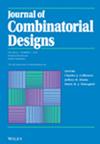求助PDF
{"title":"周期长度小于10的正交循环系","authors":"Selda Küçükçifçi, Emine Şule Yazıcı","doi":"10.1002/jcd.21921","DOIUrl":null,"url":null,"abstract":"<p>An <math>\n <semantics>\n <mrow>\n <mi>H</mi>\n </mrow>\n <annotation> $H$</annotation>\n </semantics></math>-decomposition of a graph <math>\n <semantics>\n <mrow>\n <mi>G</mi>\n </mrow>\n <annotation> $G$</annotation>\n </semantics></math> is a partition of the edge set of <math>\n <semantics>\n <mrow>\n <mi>G</mi>\n </mrow>\n <annotation> $G$</annotation>\n </semantics></math> into subsets, where each subset induces a copy of the graph <math>\n <semantics>\n <mrow>\n <mi>H</mi>\n </mrow>\n <annotation> $H$</annotation>\n </semantics></math>. A <math>\n <semantics>\n <mrow>\n <mi>k</mi>\n </mrow>\n <annotation> $k$</annotation>\n </semantics></math>-orthogonal <math>\n <semantics>\n <mrow>\n <mi>H</mi>\n </mrow>\n <annotation> $H$</annotation>\n </semantics></math>-decomposition of <math>\n <semantics>\n <mrow>\n <mi>G</mi>\n </mrow>\n <annotation> $G$</annotation>\n </semantics></math> is a set of <math>\n <semantics>\n <mrow>\n <mi>k</mi>\n </mrow>\n <annotation> $k$</annotation>\n </semantics></math><math>\n <semantics>\n <mrow>\n <mi>H</mi>\n </mrow>\n <annotation> $H$</annotation>\n </semantics></math>-decompositions of <math>\n <semantics>\n <mrow>\n <mi>G</mi>\n </mrow>\n <annotation> $G$</annotation>\n </semantics></math> such that any two copies of <math>\n <semantics>\n <mrow>\n <mi>H</mi>\n </mrow>\n <annotation> $H$</annotation>\n </semantics></math> in distinct <math>\n <semantics>\n <mrow>\n <mi>H</mi>\n </mrow>\n <annotation> $H$</annotation>\n </semantics></math>-decompositions intersect in at most one edge. When <math>\n <semantics>\n <mrow>\n <mi>G</mi>\n <mo>=</mo>\n <msub>\n <mi>K</mi>\n <mi>v</mi>\n </msub>\n </mrow>\n <annotation> $G={K}_{v}$</annotation>\n </semantics></math>, we call the <math>\n <semantics>\n <mrow>\n <mi>H</mi>\n </mrow>\n <annotation> $H$</annotation>\n </semantics></math>-decomposition an <math>\n <semantics>\n <mrow>\n <mi>H</mi>\n </mrow>\n <annotation> $H$</annotation>\n </semantics></math>-system of order <math>\n <semantics>\n <mrow>\n <mi>v</mi>\n </mrow>\n <annotation> $v$</annotation>\n </semantics></math>. In this paper, we consider the case <math>\n <semantics>\n <mrow>\n <mi>H</mi>\n </mrow>\n <annotation> $H$</annotation>\n </semantics></math> is an <math>\n <semantics>\n <mrow>\n <mi>ℓ</mi>\n </mrow>\n <annotation> $\\ell $</annotation>\n </semantics></math>-cycle and construct a pair of orthogonal <math>\n <semantics>\n <mrow>\n <mi>ℓ</mi>\n </mrow>\n <annotation> $\\ell $</annotation>\n </semantics></math>-cycle systems for all admissible orders when <math>\n <semantics>\n <mrow>\n <mi>ℓ</mi>\n <mo>∈</mo>\n <mrow>\n <mo>{</mo>\n <mrow>\n <mn>5</mn>\n <mo>,</mo>\n <mn>6</mn>\n <mo>,</mo>\n <mn>7</mn>\n <mo>,</mo>\n <mn>8</mn>\n <mo>,</mo>\n <mn>9</mn>\n </mrow>\n <mo>}</mo>\n </mrow>\n </mrow>\n <annotation> $\\ell \\in \\{5,6,7,8,9\\}$</annotation>\n </semantics></math>, except when <math>\n <semantics>\n <mrow>\n <mi>ℓ</mi>\n <mo>=</mo>\n <mi>v</mi>\n </mrow>\n <annotation> $\\ell =v$</annotation>\n </semantics></math>.</p>","PeriodicalId":15389,"journal":{"name":"Journal of Combinatorial Designs","volume":"32 1","pages":"31-45"},"PeriodicalIF":0.8000,"publicationDate":"2023-09-25","publicationTypes":"Journal Article","fieldsOfStudy":null,"isOpenAccess":false,"openAccessPdf":"","citationCount":"0","resultStr":"{\"title\":\"Orthogonal cycle systems with cycle length less than 10\",\"authors\":\"Selda Küçükçifçi, Emine Şule Yazıcı\",\"doi\":\"10.1002/jcd.21921\",\"DOIUrl\":null,\"url\":null,\"abstract\":\"<p>An <math>\\n <semantics>\\n <mrow>\\n <mi>H</mi>\\n </mrow>\\n <annotation> $H$</annotation>\\n </semantics></math>-decomposition of a graph <math>\\n <semantics>\\n <mrow>\\n <mi>G</mi>\\n </mrow>\\n <annotation> $G$</annotation>\\n </semantics></math> is a partition of the edge set of <math>\\n <semantics>\\n <mrow>\\n <mi>G</mi>\\n </mrow>\\n <annotation> $G$</annotation>\\n </semantics></math> into subsets, where each subset induces a copy of the graph <math>\\n <semantics>\\n <mrow>\\n <mi>H</mi>\\n </mrow>\\n <annotation> $H$</annotation>\\n </semantics></math>. A <math>\\n <semantics>\\n <mrow>\\n <mi>k</mi>\\n </mrow>\\n <annotation> $k$</annotation>\\n </semantics></math>-orthogonal <math>\\n <semantics>\\n <mrow>\\n <mi>H</mi>\\n </mrow>\\n <annotation> $H$</annotation>\\n </semantics></math>-decomposition of <math>\\n <semantics>\\n <mrow>\\n <mi>G</mi>\\n </mrow>\\n <annotation> $G$</annotation>\\n </semantics></math> is a set of <math>\\n <semantics>\\n <mrow>\\n <mi>k</mi>\\n </mrow>\\n <annotation> $k$</annotation>\\n </semantics></math><math>\\n <semantics>\\n <mrow>\\n <mi>H</mi>\\n </mrow>\\n <annotation> $H$</annotation>\\n </semantics></math>-decompositions of <math>\\n <semantics>\\n <mrow>\\n <mi>G</mi>\\n </mrow>\\n <annotation> $G$</annotation>\\n </semantics></math> such that any two copies of <math>\\n <semantics>\\n <mrow>\\n <mi>H</mi>\\n </mrow>\\n <annotation> $H$</annotation>\\n </semantics></math> in distinct <math>\\n <semantics>\\n <mrow>\\n <mi>H</mi>\\n </mrow>\\n <annotation> $H$</annotation>\\n </semantics></math>-decompositions intersect in at most one edge. When <math>\\n <semantics>\\n <mrow>\\n <mi>G</mi>\\n <mo>=</mo>\\n <msub>\\n <mi>K</mi>\\n <mi>v</mi>\\n </msub>\\n </mrow>\\n <annotation> $G={K}_{v}$</annotation>\\n </semantics></math>, we call the <math>\\n <semantics>\\n <mrow>\\n <mi>H</mi>\\n </mrow>\\n <annotation> $H$</annotation>\\n </semantics></math>-decomposition an <math>\\n <semantics>\\n <mrow>\\n <mi>H</mi>\\n </mrow>\\n <annotation> $H$</annotation>\\n </semantics></math>-system of order <math>\\n <semantics>\\n <mrow>\\n <mi>v</mi>\\n </mrow>\\n <annotation> $v$</annotation>\\n </semantics></math>. In this paper, we consider the case <math>\\n <semantics>\\n <mrow>\\n <mi>H</mi>\\n </mrow>\\n <annotation> $H$</annotation>\\n </semantics></math> is an <math>\\n <semantics>\\n <mrow>\\n <mi>ℓ</mi>\\n </mrow>\\n <annotation> $\\\\ell $</annotation>\\n </semantics></math>-cycle and construct a pair of orthogonal <math>\\n <semantics>\\n <mrow>\\n <mi>ℓ</mi>\\n </mrow>\\n <annotation> $\\\\ell $</annotation>\\n </semantics></math>-cycle systems for all admissible orders when <math>\\n <semantics>\\n <mrow>\\n <mi>ℓ</mi>\\n <mo>∈</mo>\\n <mrow>\\n <mo>{</mo>\\n <mrow>\\n <mn>5</mn>\\n <mo>,</mo>\\n <mn>6</mn>\\n <mo>,</mo>\\n <mn>7</mn>\\n <mo>,</mo>\\n <mn>8</mn>\\n <mo>,</mo>\\n <mn>9</mn>\\n </mrow>\\n <mo>}</mo>\\n </mrow>\\n </mrow>\\n <annotation> $\\\\ell \\\\in \\\\{5,6,7,8,9\\\\}$</annotation>\\n </semantics></math>, except when <math>\\n <semantics>\\n <mrow>\\n <mi>ℓ</mi>\\n <mo>=</mo>\\n <mi>v</mi>\\n </mrow>\\n <annotation> $\\\\ell =v$</annotation>\\n </semantics></math>.</p>\",\"PeriodicalId\":15389,\"journal\":{\"name\":\"Journal of Combinatorial Designs\",\"volume\":\"32 1\",\"pages\":\"31-45\"},\"PeriodicalIF\":0.8000,\"publicationDate\":\"2023-09-25\",\"publicationTypes\":\"Journal Article\",\"fieldsOfStudy\":null,\"isOpenAccess\":false,\"openAccessPdf\":\"\",\"citationCount\":\"0\",\"resultStr\":null,\"platform\":\"Semanticscholar\",\"paperid\":null,\"PeriodicalName\":\"Journal of Combinatorial Designs\",\"FirstCategoryId\":\"100\",\"ListUrlMain\":\"https://onlinelibrary.wiley.com/doi/10.1002/jcd.21921\",\"RegionNum\":4,\"RegionCategory\":\"数学\",\"ArticlePicture\":[],\"TitleCN\":null,\"AbstractTextCN\":null,\"PMCID\":null,\"EPubDate\":\"\",\"PubModel\":\"\",\"JCR\":\"Q3\",\"JCRName\":\"MATHEMATICS\",\"Score\":null,\"Total\":0}","platform":"Semanticscholar","paperid":null,"PeriodicalName":"Journal of Combinatorial Designs","FirstCategoryId":"100","ListUrlMain":"https://onlinelibrary.wiley.com/doi/10.1002/jcd.21921","RegionNum":4,"RegionCategory":"数学","ArticlePicture":[],"TitleCN":null,"AbstractTextCN":null,"PMCID":null,"EPubDate":"","PubModel":"","JCR":"Q3","JCRName":"MATHEMATICS","Score":null,"Total":0}
引用次数: 0
引用
批量引用

 求助内容:
求助内容: 应助结果提醒方式:
应助结果提醒方式:


